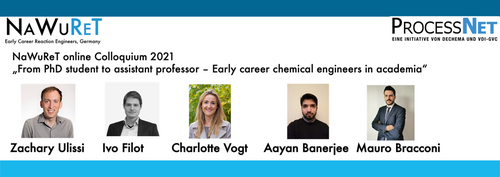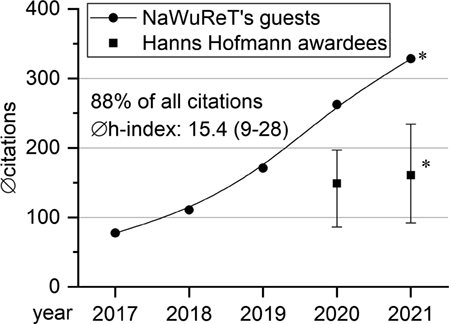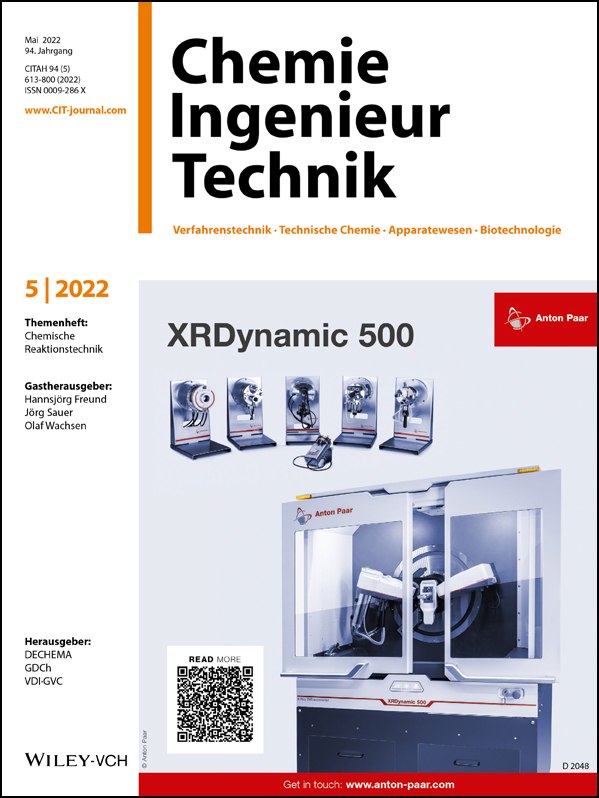NaWuReT Colloquium: From PhD Student to Assistant Professor – Early Career Chemical Engineers in Academia
Abstract
The Nachwuchs Reaktionstechnik (NaWuReT) are early-career scientists from the ProcessNet Division Reaction Engineering. In autumn 2021, they organized an online colloquium with international early-career scientists from the chemical engineering community. Five guests were invited to give a scientific talk and provide insights into their career paths. The guests gave advice and emphasized the main challenges and opportunities during their early careers. Crucial points are networking, guidance, mentoring, as well as funding acquisition and the personal work-life balance.
Why Another Online Colloquium?
We all know our time is limited and there are a lot of talks and scientific conferences offering enlightenment in different fields of reaction engineering. The number of accessible scientific articles is exponentially increasing in the last decades 1. However, there is not enough time to read all the articles. Today's interconnected world demands a lot from early-career scientists, besides the fact that this career phase typically coincides with starting a family. In order to support early-career scientists, many mentoring programs have been initiated in certain fields or institutions.
Although this is not the main business of the NaWuReT, we thought that we can contribute to these aspects by offering our core competence of networking and collaboration. The core of the NaWuReT is to bring together early-career scientists from the reaction engineering community, both from academia and industry, exchange experiences, ideas, and visions, and discuss recent developments in the field. Therefore, the idea came up to use the digital competencies we all have gained since the Corona pandemic and use these to connect those who are interested with the ones offering expertise.
We were interested in the following: What is required to become a recognized scientist? What are the main career steps? A PhD degree, of course, is the starting point for a scientist. Yet, the main work starts after the PhD, when you have to show your persistent passion for science. Typically, the passion for science is tested during the time serving as a postdoctoral researcher, who are sometimes referred to as the backbone of science. Scientific challenges aside, there are also other difficulties to overcome, like fixed-term employment contracts, simultaneous planning of career and family and high demands in terms of workload, endurance, and local/spatial flexibility 2, 3. Therefore, the NaWuReT had the idea to invite internationally recognized early-career scientists who successfully mastered the postdoc level and became assistant professors. We had the intention to get in touch with their research, but even more to get an insight into their career journey. An online format was chosen, bringing together early-career scientists from Germany and our guests from all over the world. The NaWuReT colloquium was held online in autumn 2021.
Our Guests
The NaWuReT colloquium should be attractive for as many reaction engineers as possible. Therefore, guests from different areas of reaction engineering and related fields were invited. Finally, we received the commitment of five internationally distinguished scientists. The participants of the colloquium should be set in motion by the guest's research, but also by their career paths. The illustrious set of speakers is shown in Tab. 1 and Fig. 1.
|
Name |
Affiliation |
Main scientific field |
Beginning of assistant professorship |
|---|---|---|---|
|
Zachary Ulissi |
Carnegie Mellon University, Pittsburgh, USA |
Machine learning models in catalysis |
2017 |
|
Ivo Filot |
Eindhoven University of Technology, Eindhoven, the Netherlands |
Advanced microkinetic modeling |
2015 |
|
Charlotte Vogt |
Technion, Haifa, Israel |
Spectroscopic investigations |
2021 |
|
Aayan Banerjee |
University of Twente, Twente, the Netherlands |
Multiscale modeling |
2020 |
|
Mauro Bracconi |
Politecnico di Milano, Milan, Italy |
CFD and multiscale modeling |
2018 |

The scientific topics addressed by our guests covered all scales in reaction engineering: from the atomistic scale of heterogeneous catalysis to the plant level and from single molecules to reactive flows. Additionally, our guests covered different stages as assistant professors. Their scientific background is as different as their individual career pathways. Here are brief portraits of our guests in three sentences:
Zachary Ulissi studied physics (BS), chemical engineering (BE) at the University of Delaware, USA, and applied mathematics (MA) at the University of Cambridge. He received his PhD in chemical engineering from the Massachusetts Institute of Technology in 2015. After his postdoc at Stanford University, he established his group with a strong focus on machine learning to design materials at the atomistic scale.
Ivo Filot studied chemical engineering and chemistry at Eindhoven University of Technology, the Netherlands and completed his studies in 2009 with a Master's degree. He finished his PhD in the field of quantum chemistry of the Fischer-Tropsch reaction in 2015 and became an assistant professor shortly after. The main research focus lies in the field of theoretical chemistry and computational catalysis, where microkinetic models and density functional theory are applied.
Charlotte Vogt studied chemistry and business management at Utrecht University in the Netherlands and finished her studies in 2015. Afterward, she worked on her PhD focusing on the fundamental concepts of catalysis applied for the Sabatier reaction (CO2 methanation). After a fellowship at the Weizmann Institute of Science, she became assistant professor at the Technion Institute for Technology in Haifa, Israel, in March 2021.
Aayan Banerjee studied mechanical engineering (BE) at Birla Institute of Technology, India, and continued his studies at the University of Minnesota (MS). He did his PhD research on solid oxide fuel cells at Karlsruhe Institute of Technology and received his PhD in chemical engineering in 2018. After his postdoc at the Imperial College, he became assistant professor at University of Twente in 2020.
Mauro Bracconi studied chemical engineering at bachelor and master level at Politecnico di Milano, Italy, and finished his studies in 2014. He continued his career in Milan, with a short intermezzo at BASF in Ludwigshafen and at the University of Manchester and received his PhD in 2018. He is currently an assistant professor at Politecnico di Milano and continues his work on CFD and multiscale modeling in the context of process intensification.
How influential are the invited guests? One measure is the scientific output of a researcher. The impact and progress of the guests of the colloquium can be seen in Fig. 2, where the average citations of articles in the last five years are given. Since the career status of the scientists vary, averaged values are used for all guests. The examined time frame includes 88 % of all citations of our guests. It can be seen that the number of citations has more than tripled over the five years. With the citations, the scientists achieve an average h-index of 15.4, with individual indices ranging from 9–28. For comparison, the average citation and the range of citations of the Hanns Hofmann awardees1) in the years 2016–2020 are shown. The number of average citations indicate a huge difference; however, the awardees obtain an h-index between 11 and 15, which indicates a less significant difference. Therefore, we can have a look at the individual h-indexes of our guests. We discover that apparently modeling on the microscale (or nanoscale) is a profitable scientific field and second, the h-index correlates with the time since becoming assistant professors (Zachary: 21, Ivo: 28).

-
Highly cited papers carry no more weight than any other paper.
-
Single-author papers are counted similarly to co-authorships in multiauthor papers.
-
The h-index represents an accumulated quantity and is not a parameter that describes the current scientific influence.
It is noteworthy to underline that it is usually desirable to have a set of bibliometric indicators, where each characterizes a different aspect of the scientific impact of a scientist 4. Based on this information, we can conclude that the international guests are at least as successful as the awardees of the national Hanns Hoffmann Award.
Guidance and Mentoring
Guidance and mentoring are crucial parts of becoming a successful scientist. While just a few scientists attribute importance to the impact of university professors on their career choice 6, the necessity for postdocs is the positioning in the scientific community 7, which needs advice. Surveys and testimonies confirm the promotional effects of a mentoring circles program, for example, at the Brigham and Women's hospital in Boston, where not a one-on-one but a peer-to-peer mentoring in networks was established 8.
Our guests also pointed out the importance of mentoring. Each of them highlighted the special connection with mentors. While Charlotte particularly highlighted the trustful collaboration with her doctoral supervisor Prof. Weckhuysen, Zachary stated that not a single person, but the entire network can provide guidance. However, it might be hard to get in contact with your desired mentor. Zachary was only able to get in touch with Prof. Nørskov with a little persistence, he told us with a smile. Sometimes the first email does not arrive, or it does not arrive at the right time. After the establishment, the connection can exceed the time of close collaboration. Even though Ivo became an assistant professor already six years ago, his PhD supervisors are still mentors and are providing some sort of blueprint for his own work with his PhD students. Aayan really enjoyed the feedback of his supervisors, who are still providing guidance, also in his new role as assistant professor. He said that the key is an honest discussion about scientific topics and the next career steps. This is also the advice from Charlotte: You need someone who fits your needs, your energy, and your character – someone catalyzing your development.
Obstacles Becoming Assistant Professor
Typically, there are two options to become an assistant professor in the Netherlands, Ivo explained: Either there is a vacancy and you become adjunct staff member, or you fund your own position for the first years until you proved to be able to acquire your own funding. You have to know the scientific culture in the specific country, though. Mauro clarified that there are two levels in Italy. During the first level, you have no tenure track, but you have the same responsibilities as the second level assistant professors, who have a tenure track. After a positive evaluation of the second level, you can become an associated professor. Overall, this process takes a minimum of six and up to ten years. The result is an insecure position over a long time in a system, which is unfortunately additionally characterized by a decreasing number of positions towards the full professorship. The non-permanent contracts of scientists have a crucial influence on the job satisfaction, as recently investigated in a representative study for European countries 9. Castellacci and Viñas-Bardolet showed that there is a typical minimum in job satisfaction of scientists between age 30 and 45 and that the satisfaction can be increased by a permanent contract 9.
The assistant professors have to wait to get to a permanent position and the obstacles are huge. It is not just about science, but more about the increasing number of responsibilities. You have to get funding, teach the students, and manage a research group with its members. Sometimes it is a challenge to manage the project because some do not fit perfectly with the research line. When you get the funding, you have to organize it, said Ivo. In the end, the perfect balancing of your students' supervision, your own research, and the educational duties is the main challenge. In some cases, you are lucky and find an unintended path, like Charlotte at Technion. She enjoyed working in academia, but she did not want to visit the high-ranked universities like Stanford or MIT. Instead, she nearly skipped her postdoc (only 2–3 months) and became an assistant professor. Her main arguments were the good work-life balance in Israel and the excellent funding options for fundamental science. It is known that there are several factors reducing the insecurity in academic careers. In general, mobility and networking are key to reduce the insecurity. However, also structural factors (in higher education organizations) have an influence on the insecurity 3. With this choice, Charlotte used her mobility to get into a new science system, which improved her life quality and is completely different from the expectations, e.g., in the Netherlands. Aayan mentioned that there is a focus on industrial interests in the Netherlands and that you have to have connections to the industry if you want to be successful in funding acquisition. Mauro sees the pathway towards assistant professor as a development with a different focus. During the PhD, the students are only focused on their own research outlined by a research project. During the postdoc, there is even more work, and it needs more engagement because you have to plan the research activities on your own. Finally, the assistant professor needs all these competencies and uses them to acquire projects and teach classes. In the end, there is more freedom and there are more possibilities to create, but also more effort.
Therefore, the work-life balance is a crucial point to balance the commitment and time to recover. The work-life balance, or to phrase it better, the imbalance of work and life challenges most of the postdocs and assistant professors 10. The balance is different for everyone and usually requires frequent adjustment. As mentioned before, Charlotte likes her work at Technion because of the good work-life balance. Zachary is a passionate biker and takes his free time for a ride in nature. He recommends conscious counterbalancing for personal well-being.
The “Ultimate” Masterplan
Is there an ultimate masterplan? Zachary would strongly disagree – in most cases, the masterplan is just storytelling after everything has already happened. Still, a future plan is always needed. For example, if you are changing your position, try to gain new skills. Nevertheless, some decisions are based on different aspects, which are not always specific for the scientific career (e.g., family). Aayan told us that there should be the aim to increase the line of knowledge. It is not required to be top-notch, but it is necessary to stay tuned. Therefore, you have to keep an eye on the most recent developments and be creative in synthesizing new ideas. It has been proven that sometimes the personal development takes longer. The journal article with the highest impact can be written at any time between the first and last paper during the scientific career 1.
There are already fortune tellers, which can predict career stages based on social media content. The performance is in the range of 60 to 80 % accuracy, though 11. A combination of multiple social media platforms (Twitter + Facebook + LinkedIn) increases the accuracy, but significantly, the accuracy from the career platform LinkedIn has the worst accuracy 11. However, this study did not examine the field of scientific careers. In the field of chemical engineering, we can stick to the advice of Cybulskis et al., who presented 10 key guidelines for initiating a research-focused academic career 7. From these guidelines, we would like to point out number IV, because this was one of the take-home messages of all our guests: “Be excited about what you have to say!”.
You have to enjoy what you are doing, “love it” (Aayan) and “the work should be satisfying” (Ivo). Additionally, “the career in academia is sometimes a result of the curiosity and the perspective”, Mauro stated. At the beginning of his PhD, Mauro had no intention to stay in academia, but this changed in the second part of his PhD. He gave the advice to stay in academia if there is a will and the motivation to try your best and face the difficulties. “Do not discount your desire to stay in academia”, Aayan added, “be enthusiastic”!
Feedback and Follow-up
A final survey among the participants was conducted after the event, which confirmed that the colloquium was very successful. About 30 participants listened to the lectures on the different dates. The feedback was unanimous: the participants perceived the period, the chosen structure and the duration of the individual sessions very positively. Many participants would like to see more episodes of the colloquium, which fuels the motivation of the NaWuReT to organize future events. Participants would also like more interactive elements. A special interest was announced for early-career scientists in industry so that a special need can be seen here. The NaWuReT likes to strengthen its position in the industrial sector, which is traditionally underrepresented in the scientific community and should be given greater consideration in the future.
Acknowledgements
The NaWuReT invites interested early-career scientists both from academia and industry to get involved and participate in our group. The NaWuReT thanks all speakers of the colloquium and the participants for their commitment and interest. Furthermore, the NaWuReT thanks ProcessNet Division Reaction Engineering for constant support. Open access funding enabled and organized by Projekt DEAL.
References
- 1) The prize is awarded in honor of Prof. Dr. rer. Nat. Dr.-Ing. E.h. Hanns Hofmann. He has left an outstanding mark on chemical reaction engineering in Germany. The prize is awarded for fundamental and original research work by young scientists whose PhDs were awarded no more than 8 years ago and who have developed their own scientific profile in the field of chemical reaction engineering.




